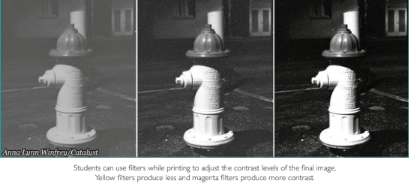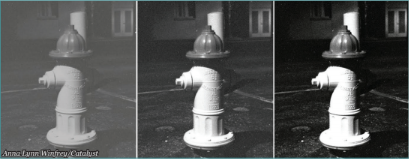In an era of augmented reality-enhanced Snapchat filters and VSCO girls, film cameras may seem like a relic of bygone times. While most students have smartphones outfitted with powerful cameras and instant sharing capabilities, some relish the slow, labor-intensive process of film photography in a corner of Hamilton “Ham” Center that does not see much light.

Second-year Jess Franks is the Darkroom Teaching Assistant (TA) and first got into film photography at the end of high school. One of her friends shot photos on film and taught Franks the basics on her grandpa’s old camera.
“When I got here, I had film and I saw that there was a darkroom and there were hours and I was like, ‘Wait! This is perfect,’” Franks recalled. “I started going to hours and that’s when I started learning how to do things. And then I just kept coming to hours because I thought it was really dope.”
Students can check out cameras and other photography equipment from the darkroom free of charge. Rolls of black and white film have been ordered and will be available soon. The darkroom is funded by the New College Student Alliance (NCSA) and receives $718 per year, according to the most updated budget.
Film cameras function because film is extremely reactive to light. When a photographer takes a picture, they adjust the settings on the camera so the correct amount of light will be exposed onto the film.
“I understand when I change the settings like aperture or f-stop I know what I’m doing, and I know why I’m doing it,” Franks said.
After assuring the subject is in focus, the photographer opens the shutter for a split second and the light exposes a specific frame of film, which produces a negative image. The film is then rolled to the next section to be exposed. If the film catches any extraneous light before developing, the picture will be altered and could be ruined.
Franks also teaches students how to process their own film and use enlargers to make their own prints. Only black and white processing is available because color processing requires finicky temperature control and different chemicals.
The first step of film processing entails going into total darkness, opening the film canister, rolling the film onto a developing spool and placing it into a light-tight developing tank. Once the lid is securely fastened, the tank can be brought into the light. The film bathes in four different chemicals and is thoroughly rinsed with water. After drying in a tall cabinet, the film is ready to be enlarged and printed, which is Franks’ favorite part of the darkroom.
Printing functions similarly to exposing negatives. Light shines through the negatives for a set amount of time onto light-sensitive paper, which reacts to the same chemicals as negative film processing to produce a positive image on the paper. However, since the paper does not react to lower frequencies of light, black and white printing does not require total darkness, so the room is aglow with red light.
While digital photographers depend on electronic components from internal camera sensors to photo-editing computer programs, film photographers control physical variables, such as altering developing times or adding contrast-altering filters. Although the entire process takes more time, Franks finds it more rewarding.
“Even though it is a much more tedious and longer process to get a photo, it’s extremely satisfying afterwards and there’s so much that you can change along the way,” Franks said. “A picture is so much more than a picture when you have all of these different things you can do to it.”
“I think something about a printed picture is different than one online,” she continued. “Something that’s physically there for you to look at is really cool. And I just love doing it.”
Students looking to dabble in film photography can stop by the darkroom on Wednesday and Friday evenings between 6:00 and 7:30 p.m. Franks is also available to set up alternate meeting times for those with conflicting schedules. Her email is To get to the darkroom in Ham Center, walk down the hallway past the double-door exit to the Nook and Black Box Theater costume closet and turn right.

